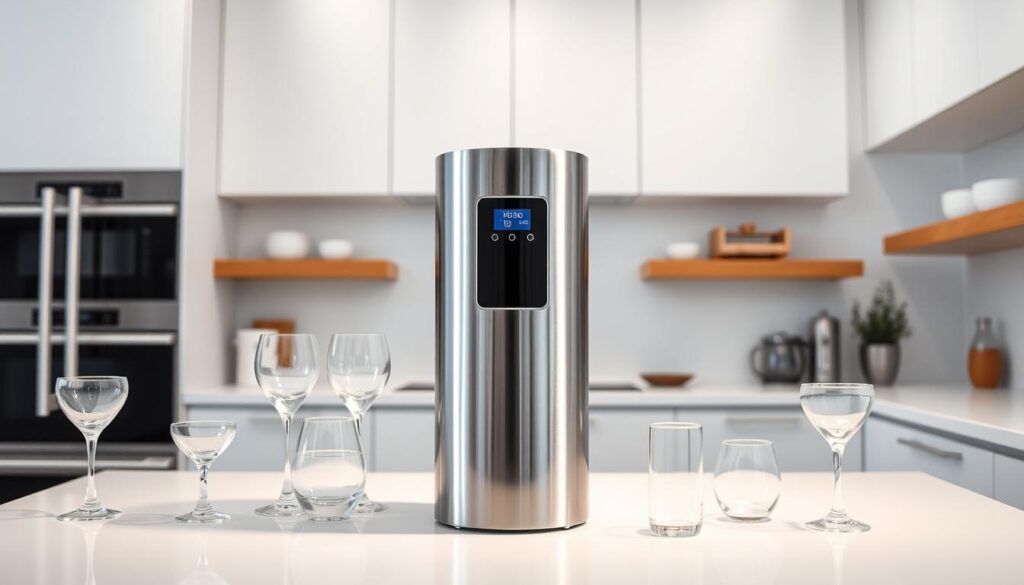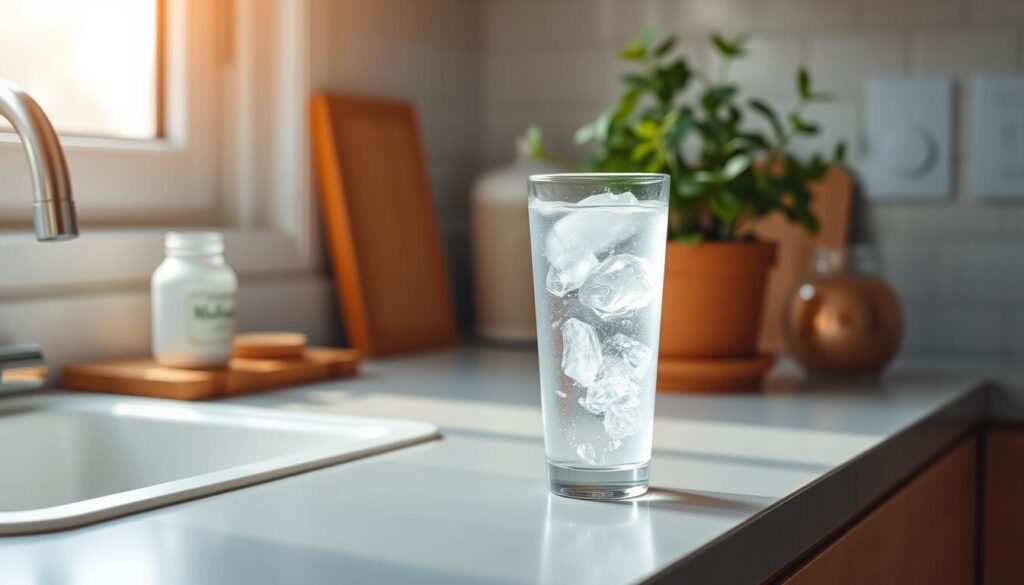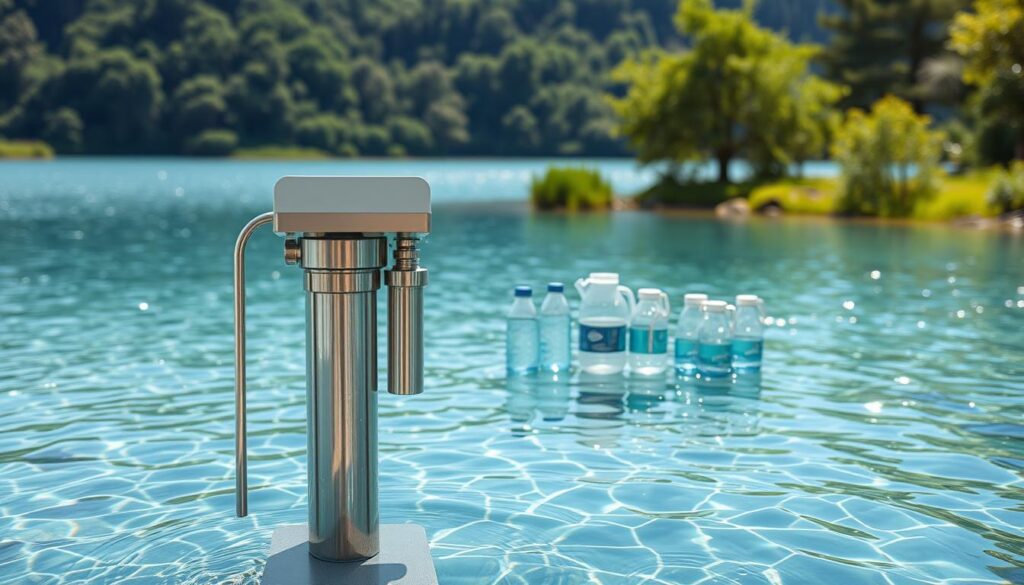I’ve always been worried about the quality of my drinking water. So, I’ve looked into many ways to purify it. Reverse osmosis stands out because it uses a special membrane to get rid of bad stuff.
I’ve checked out many reverse osmosis systems. I’m happy to share my favorites and give you tips on setting them up. This article will take you into the world of reverse osmosis. We’ll see why it’s great for clean drinking water.
Key Takeaways
- Learn about the effectiveness of reverse osmosis in removing contaminants
- Discover my top picks for reverse osmosis systems
- Get tips on how to install a reverse osmosis system in your home
- Understand the benefits of using a reverse osmosis system
- Find out what to look for when choosing a reverse osmosis system
What Are Reverse Osmosis Water Filters?
It’s important to know how reverse osmosis water filters work. These systems remove many contaminants from water. This makes the water taste better, smell fresher, and safer to drink.
Understanding the Reverse Osmosis Process
Reverse osmosis filters water through a special membrane. This membrane catches contaminants based on their size and charge. It’s great at removing dissolved solids, bacteria, viruses, and more.
To learn more about how reverse osmosis works, check out Freshwater Systems.
Key Components of a RO System
A RO system has a few main parts:
- A pre-filter catches big particles and protects the RO membrane
- The RO membrane filters out dissolved solids and contaminants
- A post-filter improves the taste and smell of the water
- Some systems have extra filters, like UV filters or mineral add-ons
When picking a RO system, think about its filtering power, upkeep, and price. For example, the iSpring RCC7 is a good choice. It’s affordable and removes all chlorine, fluoride, and more.
Knowing about reverse osmosis filters helps you choose the best one. This ensures you have clean, safe water to drink.
Benefits of Using Reverse Osmosis Water Filters
Reverse osmosis water filters offer many benefits, like better taste and removing contaminants. I’ve tried different water filters and found RO systems to be very effective. They really improve the quality of your drinking water.
Reverse osmosis is a top-notch method for drinking water purification. It not only makes water taste better but also gets rid of many harmful substances. This makes it a great choice for homes.
Improved Taste and Odor
One big plus of using a reverse osmosis system is how it makes water taste and smell better. It removes things like chlorine and lead, giving you water that’s clean and fresh. This is great for people who don’t like the taste of tap water.
Removal of Contaminants
RO systems are great at taking out lots of bad stuff from water. They use a special membrane to block impurities, leaving you with clean water. Some common things they remove include:
- Lead
- Chlorine
- Dissolved solids
- Bacteria and viruses
- Heavy metals

Convenience and Ease of Use
Many under sink water filters, like reverse osmosis systems, are easy to use and install. They fit under your sink, giving you clean water right there. This makes them a smart choice for many homeowners.
Also, most RO systems are easy to maintain. They have features like filter change reminders and simple installation. This makes keeping them running smooth and easy.
My Top Picks for Reverse Osmosis Water Filters
I’ve tested many reverse osmosis systems and I’m excited to share my favorites with you. Choosing the right one can be tough with so many options. We’ll explore some top reverse osmosis water filters, their features, how well they work, and their prices.
Best Overall: A Detailed Review
The iSpring RCC7 is a top choice for its great filtration and durability. It has a 5-stage process, including filters and a RO membrane, for clean water. It’s praised in RO filter reviews as one of the best reverse osmosis systems for its value.
“I’ve used the iSpring RCC7 for months and it’s impressive,” says a happy customer. “The water tastes great and I’ve seen a big drop in contaminants.” It’s easy to install and has long-lasting filters, making it a great pick for homeowners.
Budget-Friendly Option: Performance vs. Price
The APEC WFS-1000 is a budget-friendly choice. It’s a top RO water filter that offers great performance at a low cost. It has a 4-stage filtration process and is simple to install and maintain. It’s a good value, even if it lacks some features of pricier models.
- 4-stage filtration process
- Easy installation and maintenance
- Affordable price point
Premium Choice: Features That Stand Out
The Bluevua RO100ROPOT is a premium reverse osmosis system. It has a 5-stage process, including a UV filter for extra protection. It also looks sleek and modern, fitting well in most kitchens.
The Bluevua RO100ROPOT shines with its advanced tech, like a high-efficiency RO membrane and long-lasting UV filter. It’s pricey, but it’s perfect for those seeking the best.
Factors to Consider When Choosing a Filter
Choosing the right reverse osmosis system involves several important factors. It’s key to understand your household’s needs and the capabilities of different systems.
First, consider the quality of your water. Testing your water can show what contaminants are present. This helps you pick a system that can remove these contaminants effectively.
Water Quality and Testing
Knowing your water quality is the first step in picking the right system. Water testing can find contaminants like lead and chlorine. This knowledge helps you choose a system that can handle these issues.
- Identify the types of contaminants present in your water.
- Determine the level of filtration required to remove these contaminants.
- Choose a reverse osmosis system that is certified to remove the identified contaminants.
Filter Replacement Cost
The cost of replacing filters is another key factor. Some systems may be cheaper upfront but cost more in the long run. Think about the long-term costs of filter replacements and maintenance when choosing a system.
Here are some points to consider:
- The frequency of filter replacements.
- The cost of replacement filters.
- Any additional maintenance requirements.
Installation Space and System Size
The space available for installation is also important. Under sink water filters are popular because they are compact. Make sure to measure your space to ensure the system fits well.
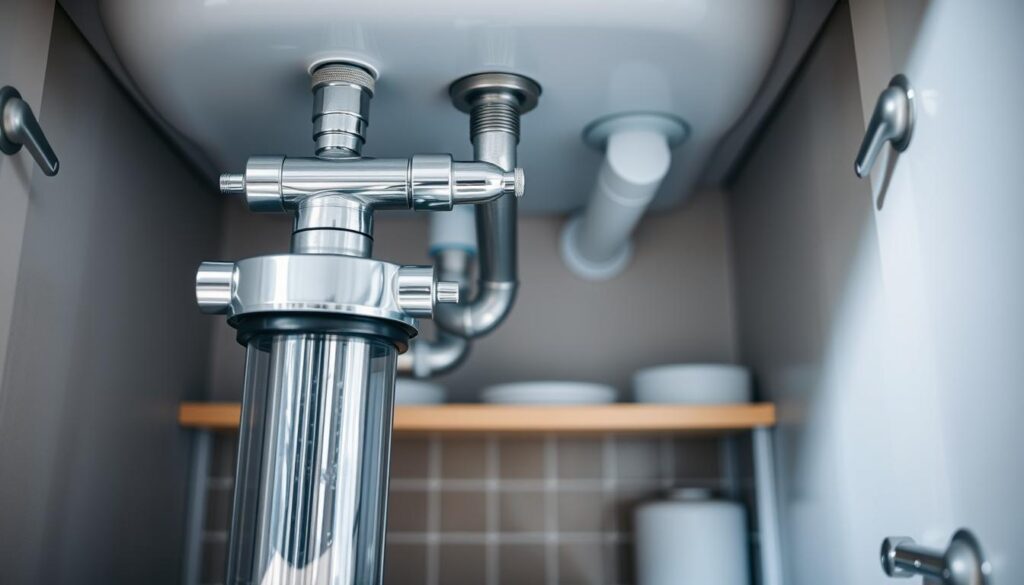
When evaluating installation space and system size, consider the following:
- The dimensions of the system and its components.
- The complexity of the installation process.
- The flexibility of the system to accommodate different plumbing configurations.
How to Install a Reverse Osmosis Water Filter
Installing a reverse osmosis water filter might seem hard, but it’s doable with the right help. Knowing the parts and following a clear guide is key to success.
First, get to know the main parts of a reverse osmosis system. You’ll need the filter unit, a special faucet, and the right tubing and fittings.
Step-by-Step Installation Guide
To set up your reverse osmosis water filter, just follow these steps:
- Turn off your home’s main water supply. Find the main shut-off valve and turn it clockwise.
- Put the filter unit under the sink and make sure it’s tight to avoid any movement.
- Connect the filter to the cold water supply line. Attach a tube to the supply line and then to the filter’s inlet valve.
- Install the faucet on your sink. You might need to drill a hole and follow the manufacturer’s instructions.
- Link the filtered water line to the faucet. Make sure all connections are tight to avoid leaks.
- Turn the water supply back on and check for leaks.
- Flush the system as the manufacturer suggests to remove air and impurities.
By following these steps, you can install your reverse osmosis water filter successfully.
Tools and Materials Needed
To install your filter, you’ll need some tools and materials:
- Tubing cutter or pipe wrench for cutting and fitting tubing
- Adjustable wrench or basin wrench for tightening fittings
- Drill (if necessary) for creating a hole for the faucet
- Teflon tape for a watertight seal on threaded connections
- The reverse osmosis filter unit and all the parts (tubing, fittings, faucet)
Having all the tools and materials ready will help make the installation easier and faster.
Maintenance Tips for Reverse Osmosis Systems
To keep your reverse osmosis system working well, regular maintenance is key. It’s not just a good idea, it’s necessary. This care ensures your system lasts longer and keeps your water clean.
Regular Filter Replacement Schedule
Replacing filters regularly is a must for your RO system. These filters are the heart of your system, filtering out bad stuff from your water. They get clogged over time, so replacing them when needed is important.
Pre-filters and post-filters should be swapped out every 6-12 months. The RO membrane might last 2-3 years, depending on how much you use it and the water quality. Keeping a maintenance log helps you remember when to replace them.
Cleaning and Sanitizing the System
It’s also important to clean and sanitize your RO system now and then. This removes any buildup or bacteria that might have formed. Sanitizing is key to stop bacteria and other tiny organisms from growing in the system.
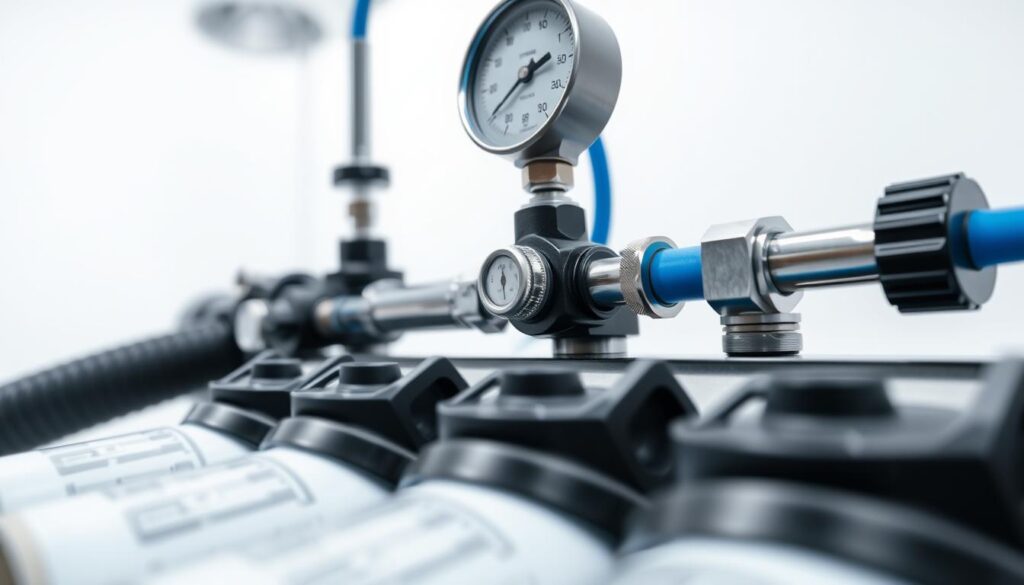
By following these tips, your reverse osmosis system will keep giving you clean, tasty water for years. Regular care not only makes your system last longer but also keeps your water quality high.
Troubleshooting Common Issues
Using reverse osmosis water filters can sometimes lead to a few common problems. These issues can be fixed with some simple troubleshooting tips. Even though these systems are built to work well, sometimes they don’t.
Low Water Flow Problems
One common problem is when your system’s water flow slows down. If your system is not producing water as fast as it used to, there are a few things to check. First, look at the filters for any blockages or sediment. Clogged filters can really slow down water flow, so replacing them might fix the problem.
Also, check the system’s tubing and connections for any kinks or blockages. These can also restrict water flow.
A quote from a water treatment expert emphasizes the importance of regular maintenance:
“Regularly checking and replacing filters is key to keeping your reverse osmosis system running well. Not doing this can lower water quality and system efficiency.”
Make sure to check the system’s pressure too. It should be in the recommended range. Low pressure can also slow down water flow.
Leaks and Drips: How to Fix Them
Leaks and drips are another common problem with reverse osmosis water filters. To fix these, start by looking for any loose connections or damaged parts. Tightening loose fittings or replacing damaged parts can usually solve the problem. It’s also a good idea to check the system’s housing and filters for any damage or wear.
- Checking and tightening all connections
- Inspecting the system’s tubing for any signs of damage or kinking
- Replacing any damaged or worn-out components
By following these troubleshooting tips, you can often fix common problems with your reverse osmosis water filter. This ensures it keeps providing clean and safe drinking water.
Enhancing Your RO System: Adding Additional Filters
To make your drinking water even safer and tastier, consider adding extra filters to your RO system. These filters can offer more protection against harmful microorganisms and improve the taste of your water.
UV Filters for Additional Protection
Adding a UV filter to your RO system can give you extra peace of mind. UV filters are very good at killing bacteria and viruses. They work by using ultraviolet light to kill any microorganisms that the RO system might not catch.
UV filters are great for people who worry about harmful microbes in their water. Make sure the UV filter you choose fits well with your RO system and meets your local water quality standards.
Mineral Add-Ons for Improved Flavor
Some people might find that RO-filtered water tastes too clean or lacks flavor because it doesn’t have enough minerals. Mineral add-ons can add back important minerals to your water, making it taste better and more nutritious. These add-ons usually contain a mix of minerals that are added to the water after it’s been filtered.
When picking a mineral add-on, think about what minerals you want to add to your water. Also, make sure it’s made for use with RO systems. The right mineral add-on can really enhance the taste and quality of your drinking water.
| Filter Type | Benefits | Considerations |
|---|---|---|
| UV Filters | Effective against bacteria and viruses, additional protection | Compatibility with RO system, local water quality standards |
| Mineral Add-Ons | Improves flavor, adds beneficial minerals | Type of minerals added, compatibility with RO system |
Comparing Reverse Osmosis to Other Filtration Methods
Reverse osmosis water filters are just one of several options for drinking water purification. It’s essential to understand their advantages and disadvantages compared to other filtration methods.
When evaluating water filtration systems, it’s important to consider their effectiveness, maintenance, and cost. We’ll compare reverse osmosis to activated carbon filters and distillation systems. These are two other popular methods for residential water filtration.
RO vs. Activated Carbon Filters
Activated carbon filters are great at removing chlorine, taste, and odor from water. They improve water quality. But, they may not be as effective against dissolved solids, heavy metals, and certain bacteria and viruses.
Reverse osmosis systems, on the other hand, are highly effective at removing a wide range of contaminants. They can remove dissolved solids, heavy metals, and microorganisms. But, they can be more complex to install and maintain than activated carbon filters.
| Feature | Reverse Osmosis | Activated Carbon |
|---|---|---|
| Effectiveness Against Dissolved Solids | High | Low |
| Removal of Chlorine and Taste/Odor | Yes, with additional filters | Yes |
| Maintenance Requirements | Regular filter replacement | Periodic filter replacement |
RO vs. Distillation Systems
Distillation systems work by boiling the water and then collecting the condensed steam. This steam is free from many contaminants. While distillation can be effective against a wide range of contaminants, it can be energy-intensive. It may not remove all volatile organic compounds (VOCs).
Reverse osmosis uses a semipermeable membrane to remove contaminants without heat. This makes it generally more energy-efficient than distillation. But, distillation can be more effective against certain contaminants that RO systems might not capture.
| Feature | Reverse Osmosis | Distillation |
|---|---|---|
| Energy Efficiency | Generally higher | Lower due to heating element |
| Effectiveness Against Bacteria/Viruses | High | High |
| Removal of VOCs | Possible with additional filters | May not remove all VOCs |
In conclusion, the choice between reverse osmosis, activated carbon, and distillation systems depends on your specific water quality concerns, maintenance preferences, and budget. By understanding the strengths and weaknesses of each method, you can make an informed decision. This decision will best suit your needs for residential water filtration.
Frequently Asked Questions About RO Water Filters
Working with reverse osmosis systems, I’ve learned that knowing about filter replacement and installation is key. People often wonder about maintenance and setup when they think about getting a reverse osmosis water filter.
How Often Should I Replace Filters?
It’s important to replace filters in your reverse osmosis system to keep the water quality high and the system running well. You should change the pre-filters and post-filters every 6 to 12 months. The RO membrane, a vital part, should be replaced every 2 to 3 years.
Key factors influencing filter replacement include:
- Water usage: If you use a lot of water, you’ll need to change filters more often.
- Water quality: If your water is not good, filters won’t last as long.
- Manufacturer’s recommendations: Always follow the manufacturer’s advice on when to replace filters.
Can I Install It Myself?
Yes, many reverse osmosis systems are easy to install yourself. But, the ease depends on the system’s design and your plumbing. “The best way to ensure a successful installation is to follow the manufacturer’s instructions and take your time.” If you’re not good at DIY or your plumbing is complicated, it’s best to get a professional.
- Understanding the system’s components and their connections.
- Ensuring you have the necessary tools and materials.
- Following the manufacturer’s step-by-step installation guide.
As
“The quality of your drinking water is only as good as the system that filters it.”
By knowing the answers to these common questions, you can make a smart choice about your reverse osmosis water filter. This way, you can enjoy clean, fresh drinking water.
Conclusion: Choosing the Right Reverse Osmosis System for My Needs
Choosing a reverse osmosis system involves looking at several things. These include how well it filters, its cost, and how easy it is to maintain. By thinking about these, you can pick the right one and have clean, tasty water.
I’ve looked into the top reverse osmosis systems. These systems are known for their great performance and value. They are great at removing bad stuff from water, making it taste and smell better.
Key Considerations for the Perfect System
To find the perfect system, think about what your household needs. Look at the water quality, how much space you have, and your budget. This helps you pick a system that works well for you.
The best system is one that filters well, is affordable, and easy to take care of. By using the tips in this article, you can choose wisely. This way, you’ll have clean, fresh water with a top-rated RO water filter.
FAQ
How often should I replace the filters in my reverse osmosis system?
The need to replace filters in a reverse osmosis system varies. It depends on your water quality and the filters’ type. Usually, pre-filters and post-filters should be swapped out every 6-12 months. The RO membrane, on the other hand, can last 2-3 years.
Can I install a reverse osmosis water filter myself?
Yes, many reverse osmosis systems are easy to install yourself. But, if plumbing isn’t your thing or you’re unsure about the process, it’s best to get a pro. They can ensure a proper and leak-free setup.
What is the difference between a reverse osmosis system and a water softener?
Reverse osmosis systems remove many contaminants, like dissolved solids, bacteria, and viruses. Water softeners, on the other hand, focus on removing minerals that make water hard, such as calcium and magnesium.
Are reverse osmosis water filters effective against lead and other heavy metals?
Yes, reverse osmosis water filters are very good at removing lead and heavy metals. The semi-permeable membrane in RO systems blocks these contaminants, making the water safe to drink.
Do reverse osmosis systems waste a lot of water?
Older reverse osmosis systems can waste some water. But, newer models often have water-saving features. For example, permeate pumps can greatly reduce water waste.
Can I use a reverse osmosis system with well water?
Yes, you can use a reverse osmosis system with well water. But, first, test your well water to know what contaminants it has. Then, pick an RO system that can handle those contaminants.
How do I maintain my reverse osmosis system?
To keep your reverse osmosis system in good shape, replace filters regularly, clean the system, and sanitize it. This prevents bacterial growth. Also, check the system’s performance and fix any problems that come up.

